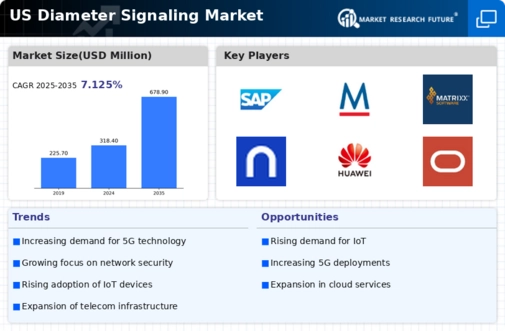Emergence of New Use Cases
The diameter signaling market is being propelled by the emergence of new use cases that require advanced signaling capabilities. With the rise of applications such as real-time analytics, video streaming, and cloud services, the need for efficient signaling protocols is becoming increasingly apparent. These applications demand high levels of performance and low latency, which can only be achieved through sophisticated signaling solutions. The diameter signaling market is likely to benefit from this trend, as service providers look to implement technologies that can support these new use cases. As the demand for innovative applications continues to grow, the market may see a corresponding increase in investment and development of signaling technologies tailored to meet these evolving needs.
Regulatory Compliance and Standards
The diameter signaling market is also shaped by the evolving landscape of regulatory compliance and industry standards. As telecommunications regulations become more stringent, service providers are compelled to adopt signaling solutions that meet these requirements. Compliance with standards such as those set by the Federal Communications Commission (FCC) is crucial for operators to avoid penalties and ensure uninterrupted service. The diameter signaling market is likely to see a rise in demand for solutions that facilitate compliance, as operators seek to align their technologies with regulatory expectations. This trend may drive innovation and investment in signaling technologies, as companies strive to develop solutions that not only meet current standards but also anticipate future regulatory changes.
Expansion of Mobile Network Operators
The diameter signaling market is significantly influenced by the expansion of mobile network operators (MNOs) across the United States. As MNOs strive to enhance their service offerings and expand their customer base, they are increasingly investing in advanced signaling solutions. This trend is driven by the need to manage growing data traffic and improve user experiences. Recent data indicates that the number of mobile subscribers in the US has surpassed 300 million, creating a pressing need for efficient signaling protocols to handle the associated data load. The diameter signaling market is likely to see increased adoption of its technologies as MNOs seek to optimize their networks and ensure seamless connectivity for their users. This expansion not only boosts the market but also fosters innovation within the diameter signaling sector.
Increased Focus on Network Reliability
The diameter signaling market is witnessing an increased focus on network reliability, driven by the growing dependence on digital services. As businesses and consumers rely more heavily on uninterrupted connectivity, the need for resilient signaling solutions becomes critical. Recent surveys indicate that over 70% of enterprises consider network reliability a top priority, influencing their technology investments. This emphasis on reliability is likely to propel the diameter signaling market forward, as companies seek to implement solutions that minimize downtime and enhance service quality. The demand for high-availability signaling systems may lead to advancements in technology, fostering a competitive landscape where reliability becomes a key differentiator among service providers.
Rising Demand for High-Speed Connectivity
The diameter signaling market is experiencing a notable surge in demand for high-speed connectivity solutions. As consumers and businesses increasingly rely on seamless internet access, the need for robust signaling protocols becomes paramount. This demand is particularly evident in urban areas, where the proliferation of smart devices and IoT applications necessitates efficient data transmission. According to recent estimates, the market for high-speed connectivity solutions is projected to grow at a CAGR of approximately 15% over the next five years. This growth is likely to drive investments in diameter signaling technologies, as service providers seek to enhance their network capabilities and meet customer expectations. Consequently, the diameter signaling market is poised to benefit from this trend, as it aligns with the broader push for faster and more reliable communication networks.






















Leave a Comment